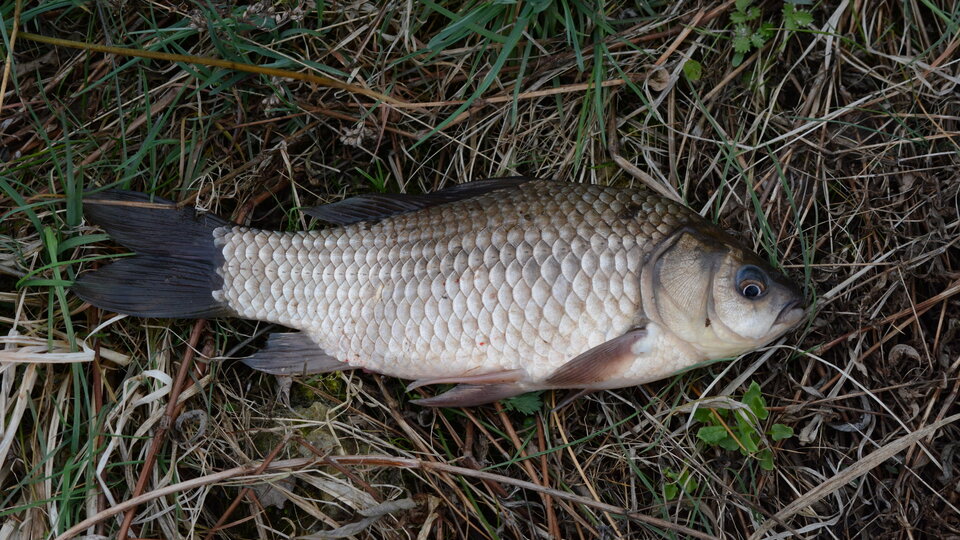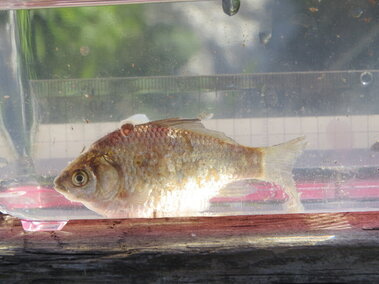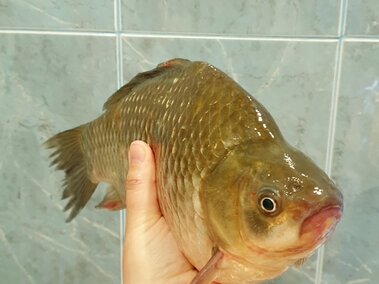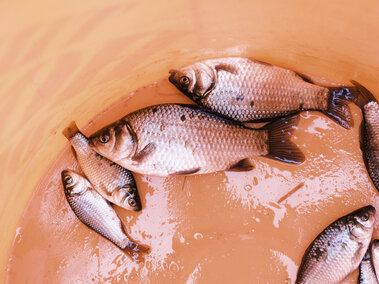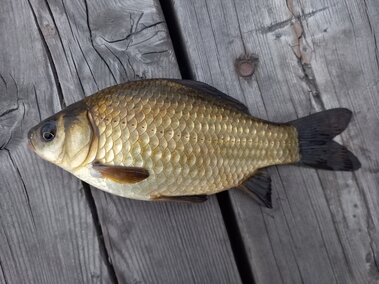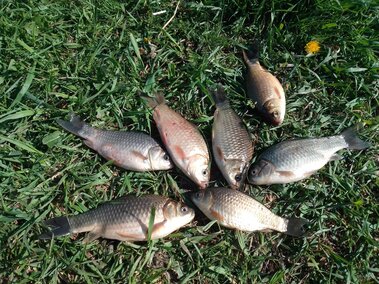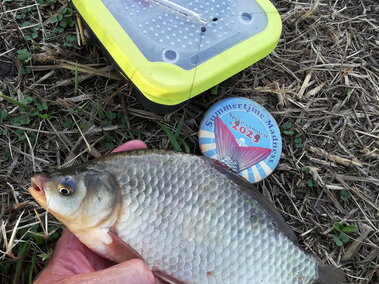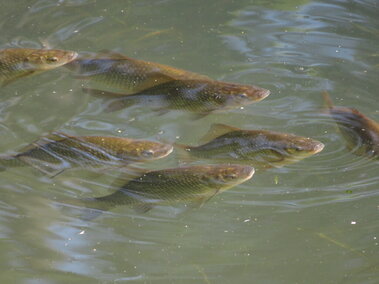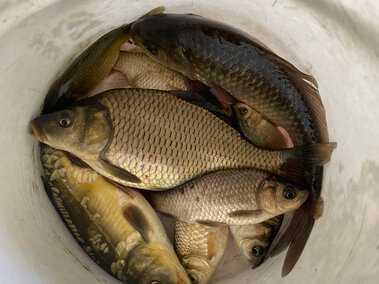General Information
Species Name: Carassius gibelio
Also Known As: gibel carp, Prussian carp, silver crucian carp
Family: Cyprinidae (Minnow)
Life Span: Up to 10 years
Life Cycle: In the northern portion of its native range where temperatures are cooler, spawning occurs at 3-4 years of age, but occurs at 1-2 years in southern Europe from May-July when water temperatures are above 14°C. Spawning occurs in shallow water along warm shorelines on submerged vegetation. Golden carp can reproduce sexually or via gynogenesis, in which the female uses the sperm from a related species (i.e., other cyprinids) to activate the development of the egg, however the sperm does not contribute to the genetic composition of the offspring. Gynogenetic populations are most prevalent in newly invaded habitats.
Origin: Europe and Asia
Injurious: Yes. Currently under the Lacey Act, golden carp are listed as injurious wildlife by the U.S. Fish and Wildlife Service, which prohibits the importation into or transportation between the continental United States, the District of Columbia, Hawaii, the Commonwealth of Puerto Rico or any territory or possession of the United States of live golden carp, gametes, viable eggs and hybrids.
Category 1: Potential Aquatic Invasive Species
Why Are They Invasive?
Golden carp have the potential to compete for resources with native species. Their habitat preference overlaps closely with sunfish (Centrarchidae). Their diet preference overlaps with suckers (Catostomidae). They can interfere with spawning of native cyprinids potentially resulting in decreased population size of native fish species. They can increase the total suspended solids in the water column, enhance the growth of planktonic algae, decrease light conditions, reduce benthic algae growth, reduce zooplankton biomass, and prevent submerged macrophyte development ultimately enhancing eutrophication.
What Do They Look Like?
The golden carp is a deep-bodied, robust fish that grows to about 10 to 35 cm (4 to 14 in) in length. Its scales are large, and it typically has 27 to 32 scales along the lateral line. The species is silvery, sometimes with a faint golden tinge. The golden carp's tail is deeply forked.
Photos
Where Do They Live?
Golden carp are recognized for their ability to thrive in habitats less suitable for most native freshwater species (i.e. hypoxia, environmental pollution, moderate salinity, turbidity and high levels of eutrophication). They live in a wide variety of fresh water bodies including ponds, lakes, and slow-running rivers and streams, usually associated with submerged vegetation and/or regular flooding events. They are generalist omnivores, feeding on plankton, benthic invertebrates, plant material, filamentous algae, and detritus. While they have established in parts of Canada, particularly in Alberta and Saskatchewan, they are not known to be established in the wild in the United States.
How Do They Spread?
The means of original introduction to North America is currently unknown but potentially occurred through contaminated shipments of other aquaculture species or through aquarium or bait fish releases. Dispersal has been facilitated by artificial irrigation waterways and likely human mediated transport.
How Do I Control Them?
Management of invasive fish involving either mechanical removal or application of chemicals to public waters requires a permit. Contact the Contact the Nebraska Game and Parks Commission for more information.
CLEAN your watercraft, trailer, angling gear and other equipment. Remove all aquatic vegetation and animal species from your equipment.
DRAIN your watercraft at the ramp by removing the boat plug and draining all live wells and ballast tanks.
DRY your watercraft, trailer and other equipment for at least 7 days before visiting another waterbody.
DON'T DUMP BAIT. Dispose of bait by emptying bait buckets on dry land, away from waterbodies or in a trash receptacle. Moving a live organism from one waterbody to another is illegal, even if you are planning to use the organism as bait.
DON'T LET IT LOOSE. Do not release or transport exotic or non-native fish species to new ecosystems. It is unlawful to release any aquatic species into a waterbody other than the one from which it was harvested. Doing so can promote the spread of AIS.
What Should I Do If I See Them in Nebraska?
If you see golden carp in Nebraska, you should report them to the Nebraska Game and Parks Commission's Aquatic Invasive Species (AIS) Program using their AIS Report Form. For guidance on what information to include in your report, check out our reporting tips.
References and More Information
Center for Invasive Species and Ecosystem Health
Nebraska Game and Parks Commission
